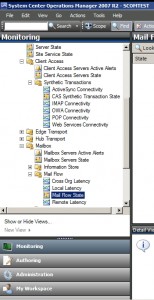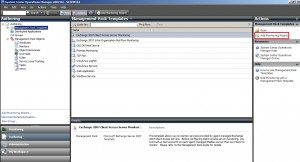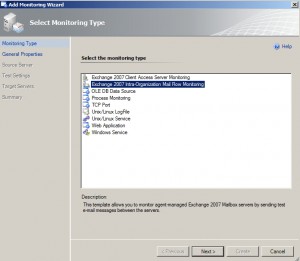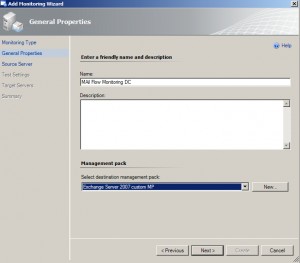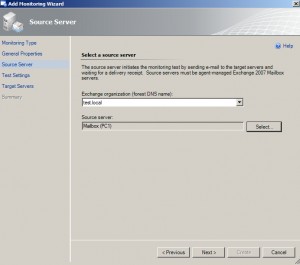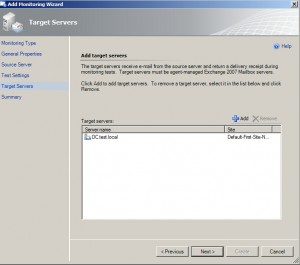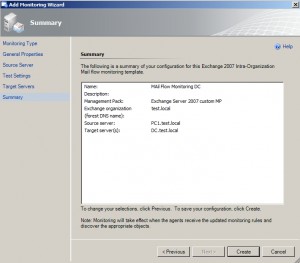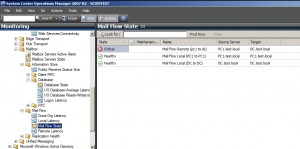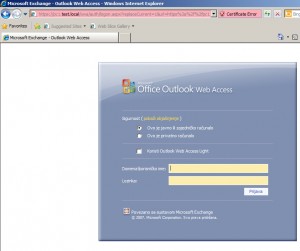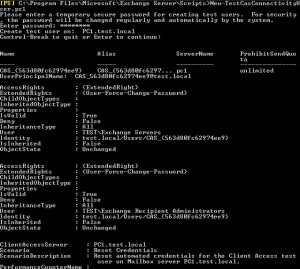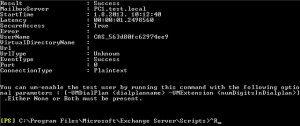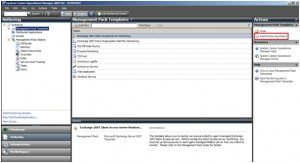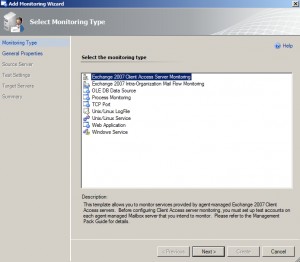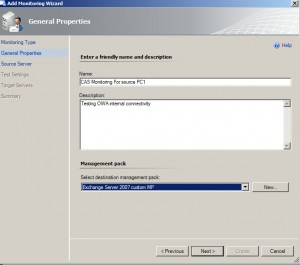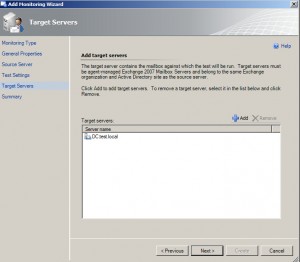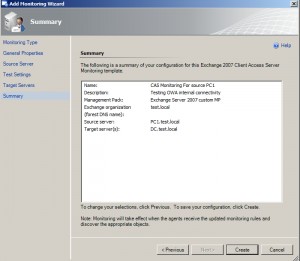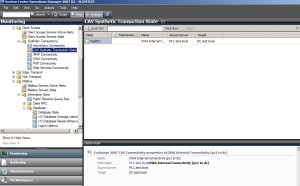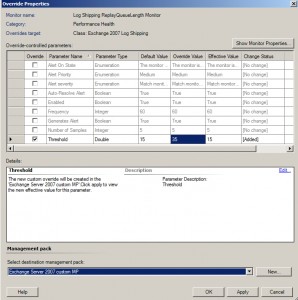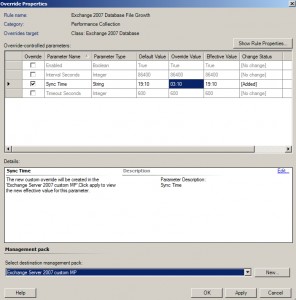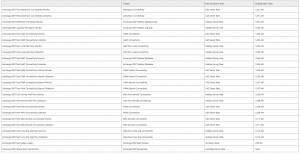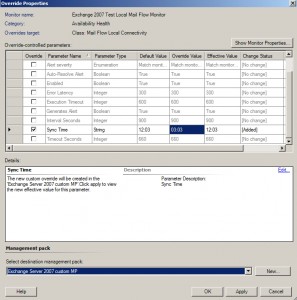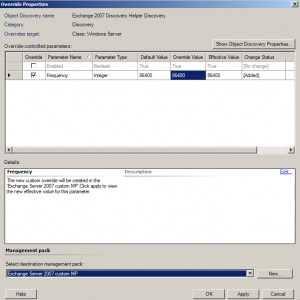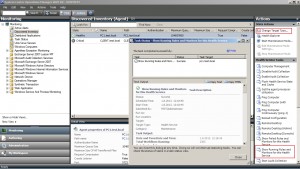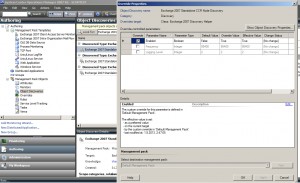This is the last part of the guide, and it`ll be covering these topics: configuration of synthetic transactions, configuration of the Log Shipping Replay Queue, adjusting the Best Time to Run Report Data Collection Scripts and troubleshooting.
If you skipped something -> back to Part 2 , back to Part 1
Configuring Synthetic Transactions
There are two types of synthetic transactions: Mail flow synthetic transactions and CAS synthetic transactions.
Mail flow synthetic transactions are divided into three groups:
Local mail flow: a server sends mail to itself
Intra-organization mail flow: a server sends mail within an organization
Inter-organization mail flow: a server sends mail to another organization/mailbox (internet)
I`ll setup only Intra-organization mail flow, since I have only one organization and my Exchange server is not published. Local mail flow testing is enabled by default on each agent managed Exchange Server 2007 Mailbox server.
CAS synthetic transactions – This type of synthetic transactions run on Client Access servers and perform transactions against the Client Access server itself and also the back-end Mailbox servers within the same site. (OWA, ActiveSync)
Intra-Organization Mail Flow
Open Operations Console |Authoring tab | Click Management Pack Templates | On Actions pane on the right choose Add Monitoring Wizard
Choose Exchange 2007 Intra-Organization Mail Flow Monitoring | Next
Enter Name and Description |Choose Management Pack | Next
Enter Exchange organization name and select source mailbox server |Next
For testing purposes I put minimal values for Test frequency 5min (values from 5-60minutes) and Time-out 1min (1-30min) You can setup according to your needs | Next
Add target server, I added DC on which currently Exchange Server 2007 Information Store service is down (I have SCR Exchange setup, so this is the way to simulate failure) , so test should result with errors. | Next
Create
Soon I checked Mail Flow state, and as I already said, it is broken, since Information Store on DC is stopped. Local mail flow is ok.
CAS Synthetic Transactions
Microsoft Office Outlook Web Access, Exchange ActiveSync, Exchange Web Services, POP3 and IMAP services are all supported in Exchange Server 2007 MP.
I`m going to test Microsoft Office Outlook Web Access in this case.
In order to test these services, special test mailbox for each Exchange Server 2007 Mailbox server is required by Operations Manager 2007 R2.
To create the test mailbox, on each Exchange 2007 Mailbox server, open the Exchange Management Shell, enter Scripts directory under the installation path for Exchange Server 2007 (C:\Program Files\Microsoft\Exchange Server\Scripts) and execute the script New-TestCasConnectivityUser.ps1
This has to be done on all mailbox servers.
Exchange 2007 CAS Monitoring
I`ll be configuring monitoring for OWA internal connectivity.
Open Operations Console |Authoring tab | Click Management Pack Templates | On Actions pane on the right choose Add Monitoring Wizard
Choose Exchange 2007 Client Access Server Monitoring | Next
Enter name and description, choose management pack | Next
Choose Exchange organization, enter Source server name | Next
Test frequency 5min | Time-out 30s | Test types: OWA Internal Connectivity | Next
Choose target server | Next
Create
Configuring the Log Shipping Queue Length Monitor for SCR and CCR
The Exchange 2007 MP contains monitors to check the Log Shipping Replay Queue Lengths for cluster continuous replication (CCR) and standby continuous replication (SCR) scenarios. This monitor (by default) raises alert if the number of transaction logs waiting to be committed is greater than 15 logs and has been waiting for more than 5 minutes.
We definitely need to configure override for this monitor, especially if you are using SCR (in my case yes), since the threshold is optimized for CCR configurations.
Open Operation Console | Choose Authoring tab | Click on Management Pack Objects | choose Monitors | Change scope to Exchange 2007 Log Shipping | Open Exchange 2007 Log Shipping | Entity Health | Performance | Right click on Log Shipping ReplayQueueLength Monitor | Override – Override the Monitor – For all objects of class: Exchange 2007 Log Shipping
Configure threshold to fit your environment | Apply | OK
Do the same procedure for Log Shipping CopyQueueLength Monitor.
Adjust the Best Time to Run Report Data Collection Scripts/Resource-Incentive Rules and Monitors
There are certain resource intensive operations, such as the Report Data Collection Scripts and a few Rules and Monitors that you should know their scheduled time to run and perform some adjustments, as these could impact normal Exchange servers operation.
The Exchange Server 2007 Reporting Management Pack collects information on a daily basis to report on a set of objects on the Exchange 2007 Mailbox Servers. To mitigate the impact on the Exchange servers, the report data collection scripts use a Sync Time parameter to ensure that the scripts only run during an assigned time period, with a default time-out value of 10 minutes. The script run times are also distributed to ensure that only one script runs at a time.
By default, the report collection scripts run according to the schedule below.
In order to change the time that the Report Data Collection Scripts run the following:
Open Operation Console | Choose Authoring tab | Click on Management Pack Objects | choose Rules | In Look for field enter Exchange Server 2007 Database File – click Find Now | Click on Type: Exchange 2007 Database | Right click Exchange 2007 Database File Growth | Override – Override the Monitor – For all objects of class: Exchange 2007 Database
Change Sync Time to fit your needs | Choose management pack |Apply |OK
Repeat for all the other rules that you need.
The next table lists a set of rules, monitors, and synthetic transactions that run according to a schedule and are resource-intensive, meaning they could also impact CPU utilization on the Exchange server when they are running.
Just like the report data collection rules, to mitigate the impact on the Exchange servers, these objects use a Sync Time parameter to minimize the number of simultaneously running rules or monitors. The script run times are also distributed to ensure that only one script runs at a time.
To change the time that the rule, monitor, or synthetic transactions run, override the Sync Time for the one you want to change. When you override the Sync Time for a rule, ensure that you use the same override for the corresponding monitor, so that rules and corresponding monitors do not run twice. This does not apply to rules that do not have corresponding monitors.
For example I`ll show required steps for Exchange 2007 Test Local Mail Flow Monitor
Open Operation Console | choose Authoring tab | click on Management Pack Objects | choose Monitors | In look for field enter: Exchange 2007 Test Local Mail Flow Monitor – click Find Now | Click on Mail Flow Local Connectivity | Right click Exchange 2007 Test Local Mail Flow Monitor | Override – Override the Monitor – For all objects of class: Mail Flow Local Connectivity
Change Sync Time to fit your needs | Choose management pack |Apply |OK
Repeat for all the other that you need in your environment.
Troubleshooting
Here are some “problems” that I had during testing process.
No Exchange 2007 Servers Discovered
If you have no Exchange 2007 Servers discovered, you should change frequency of the Exchange 2007 Discovery Helper Discovery.
It is located under Authoring | Management Pack Objects | Object Discoveries.
Look for Exchange 2007 Discovery Helper Discovery and change frequency of Discovery
Also, you can always reset you SCOM server to resolve this. : )
You can also further troubleshoot by going to Monitoring | Discovered Inventory | click on Change Type – select Agent – click OK | Select Server that you want to troubleshot and then click on Show Running Rules and Monitors for this Health Service which you`ll find under Health Service Tasks on right bottom part of the screen.
No standalone Exchange 2007 Mailbox servers discovered
Standalone Exchange 2007 mailbox servers are discovered by enabling the Exchange 2007 Standalone CCR Node Discovery.
After enabling this restart Health service on each server.
“No Exchange 2007 Mailbox Servers were found” message when configuring Intra-Organization Mail Flow Synthetic Transaction
See mailbox discovery problems. Also check if Exchange 2007 MP discovered Exchange 2007 Servers.
Conclusion
In this guide we went through Exchange 2007 Server MP and monitoring setup for SCOM 2007 R2. There are some topics that I skipped since I`m limited with resources. Edge server, Unified Messaging Connectivity Monitoring, inter-organization mail flow are some of topics that are not covered in this guide…
Exchange 2007 Server MP proved its value, now is time to test and write about System Center 2010, 2012.
